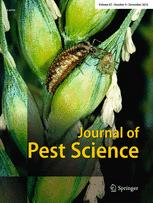Ver ítem
- xmlui.general.dspace_homeCentros Regionales y EEAsCentro Regional Patagonia NorteEEA BarilocheArtículos científicosxmlui.ArtifactBrowser.ItemViewer.trail
- Inicio
- Centros Regionales y EEAs
- Centro Regional Patagonia Norte
- EEA Bariloche
- Artículos científicos
- Ver ítem
Management of Sirex noctilio populations in exotic pine plantations: critical issues explaining invasion success and damage levels in South America
Resumen
Plantation forestry with non-native trees is steadily increasing in the southern hemisphere and alien pest problems are also accumulating, as a consequence of the growing international movement of people and goods. Here, we present an overview of studies on the ecology and on the control practices deployed against the European woodboring wasp Sirex noctilio, in South America. Management actions have been largely adopted from other southern hemisphere
[ver mas...]
Plantation forestry with non-native trees is steadily increasing in the southern hemisphere and alien pest problems are also accumulating, as a consequence of the growing international movement of people and goods. Here, we present an overview of studies on the ecology and on the control practices deployed against the European woodboring wasp Sirex noctilio, in South America. Management actions have been largely adopted from other southern hemisphere countries, although generally with very little local adaptation or critical evaluation of successes and failures. The knowledge acquired in South America
allows us to look retrospectively at critical issues that explain woodwasp invasion success and damage levels, and to identify specific research areas that warrant further work. We emphasize the need of population ecology studies in both the invaded
and native ranges, the development of specific sampling protocols, and detailed studies aimed at evaluating the role played by natural enemies in preventing large-scale population outbreaks. These demands may be generalized to the management
of other invasive pests in plantation forestry with non-native trees in the southern hemisphere.
[Cerrar]

Fuente
Journal of Pest Science 92 (1) : 131-142 (January 2019)
Fecha
2018-11
Editorial
Springer Nature
ISSN
1612-4766
1612-4758
1612-4758
Formato
pdf
Tipo de documento
artículo
Palabras Claves
Derechos de acceso
Restringido
 Excepto donde se diga explicitamente, este item se publica bajo la siguiente descripción: Creative Commons Attribution-NonCommercial-ShareAlike 2.5 Unported (CC BY-NC-SA 2.5)
Excepto donde se diga explicitamente, este item se publica bajo la siguiente descripción: Creative Commons Attribution-NonCommercial-ShareAlike 2.5 Unported (CC BY-NC-SA 2.5)

